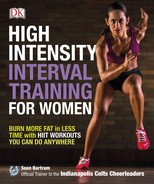How HIIT Works
Although short in duration, HIIT has a big impact. Training at your maximum capacity for intense intervals interspersed with rest or active recovery will accomplish two goals: it will help accelerate fat loss and improve both aerobic and anaerobic endurance. HIIT causes your body to burn calories and lose fat in less time than traditional “steady state” training.
High intensity
The “high intensity” part of HIIT is key. You won’t see results if you’re not pushing yourself as hard as you possibly can during the “work” intervals of your HIIT routine. Studies have shown that just seven minutes of HIIT can create changes in your muscles at a molecular level that are comparable to what you might see after an hour or more of jogging or biking. However, those changes are not apparent if you don’t work at maximum output.
Constant change
The “interval” part of HIIT is also critical. This comes into play with both the brief rest periods between exercises as well as the order of exercises themselves. As you go through a HIIT routine, you alternate between periods of all-out exertion and active recovery or rest. The brief rest periods allow your heart rate to come down and prevent your body from adapting to a steady workload.
The “after burn” effect
Not only will you burn calories and fat during your HIIT workout, you will also burn calories and fat following your workout through the “after burn” effect or EPOC (excess post-exercise oxygen consumption). EPOC is the measurable increased rate of oxygen intake following strenuous activity intended to erase the body’s oxygen debt.
In order to erase the oxygen debt, fatty acids are released and used as fuel for recovery. You cannot take advantage of this after burn by doing low-intensity exercise. Only by working anaerobically at maximal heart rate will you see this added fat loss effect. EPOC has been shown to last over 48 hours.
Are you working hard enough?
Because maximum effort is so critical to HIIT success, my clients often ask, “How do I know if I am working hard enough?” My usual answer is that if the person next to you asks you a question, you should not be able to respond. You should be able to talk between short gasps of air, but if you can carry on a conversation, you’re simply not working hard enough.
Another way to think of it is by measuring your workout intensity on a scale of 1 to 10, with 10 equal to running for your life as you are chased by a rabid beast. You should be working almost that hard during a HIIT workout, pushing yourself to a level 8 or 9. Remember that HIIT is hard. Your heart should be pounding, your breathing should be heavy, and you should be sweating.
